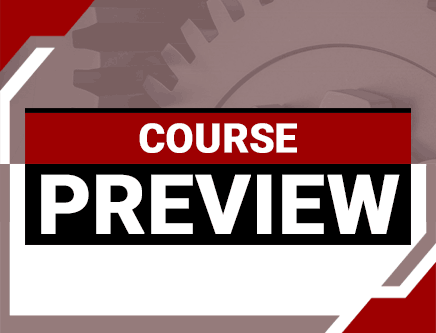Fundamentals of Shear and Moment Diagrams
In Fundamentals of Shear and Moment Diagrams, you'll learn ...
- How to construct and interpret shear force and bending moment diagrams for various beam configurations under point loads, distributed loads, and combined loading conditions.
- How to apply static equilibrium principles to calculate support reactions and internal forces in beams.
- How to identify critical locations such as maximum shear, maximum moment, zero-crossings, and points of inflection to inform structural design decisions.
- How to relate internal force behavior to real-world applications
Overview
This course introduces the fundamental concepts and techniques used to construct shear force and bending moment diagrams for beams. A core topic in structural and mechanical analysis, understanding how internal forces vary along a beam is essential for safe and efficient structural design. The course is tailored for civil, mechanical, and structural engineers, as well as engineering students and professionals seeking a practical refresher in classical structural analysis methods.
The course begins with a review of support types and how they affect reactions, followed by an introduction to distributed and concentrated loads, internal shear forces, and bending moments. Participants will learn how to systematically analyze statically determinate beams using equilibrium equations and construct accurate shear and moment diagrams through analytical methods and visual interpretation.
Key diagram features such as slope transitions, sign conventions, and relationships between load, shear, and moment will be emphasized throughout. Step-by-step examples of simply supported beams will be presented, including cases with uniform loads, point loads, and combinations thereof.
By the end of the course, participants will be able to confidently draw shear and moment diagrams and understand how they relate to beam performance, sizing, and material selection.
Specific Knowledge or Skill Obtained
This course teaches the following specific knowledge and skills:
- How to identify types of beam supports and corresponding reaction forces.
- How to analyze statically determinate beams using equilibrium equations.
- How to distinguish between types of external loading: point loads, distributed loads, and moments.
- The relationships between load, shear force, and bending moment.
- How to construct shear force and bending moment diagrams for various beam configurations.
- How to apply proper sign conventions and interpret critical points in the diagrams.
- How to use shear and moment diagrams to inform design and safety decisions in structural elements.
Certificate of Completion
You will be able to immediately print a certificate of completion after passing a multiple-choice quiz consisting of 20 questions. PDH credits are not awarded until the course is completed and quiz is passed.
| This course is applicable to professional engineers in: | ||
| Alabama (P.E.) | Alaska (P.E.) | Arkansas (P.E.) |
| Delaware (P.E.) | District of Columbia (P.E.) | Florida (P.E. Area of Practice) |
| Georgia (P.E.) | Idaho (P.E.) | Illinois (P.E.) |
| Illinois (S.E.) | Indiana (P.E.) | Iowa (P.E.) |
| Kansas (P.E.) | Kentucky (P.E.) | Louisiana (P.E.) |
| Maine (P.E.) | Maryland (P.E.) | Michigan (P.E.) |
| Minnesota (P.E.) | Mississippi (P.E.) | Missouri (P.E.) |
| Montana (P.E.) | Nebraska (P.E.) | Nevada (P.E.) |
| New Hampshire (P.E.) | New Jersey (P.E.) | New Mexico (P.E.) |
| New York (P.E.) | North Carolina (P.E.) | North Dakota (P.E.) |
| Ohio (P.E. Self-Paced) | Oklahoma (P.E.) | Oregon (P.E.) |
| Pennsylvania (P.E.) | South Carolina (P.E.) | South Dakota (P.E.) |
| Tennessee (P.E.) | Texas (P.E.) | Utah (P.E.) |
| Vermont (P.E.) | Virginia (P.E.) | West Virginia (P.E.) |
| Wisconsin (P.E.) | Wyoming (P.E.) | |


 Live support chat
Live support chat




